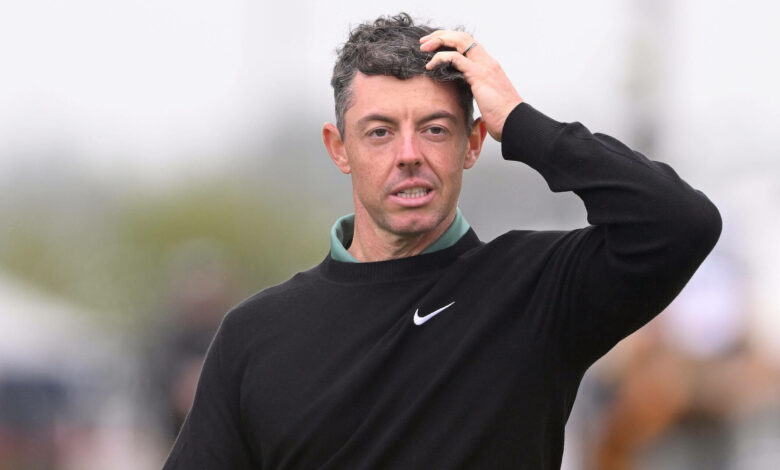Psychology of the Open Championship: How to Thrive in One of Golf’s Toughest Tests

The gusts of wind practically blow you away. Your socks are soaked. A treacherous pot bunker hangs in the corner of your eye. These are the physical sensations of the Open Championship, but the real challenge of this great test is psychological.
This week at Royal Troon, you’ll hear the broadcast analysts talk about the best links players as those who stay patient. They take their medicine. They grind it out. But what do the mental hurdles of an Open really entail, beyond the clichés? What are the specific goals and requirements that enable someone to triumph in a championship like this at Royal Troon?
Acceptance
At the Open, players are faced with a mental test that involves more than just laying out well-protected greens and fairways. Much of this test is simply beyond the player’s control. You can’t control the wind or the rain. You can’t control the tee time draw: only Mother Nature knows whether you’re going to play into a light breeze or just ahead of a hurricane. Discovering which lie you’re going to end up in the sand is a brutal shock to the system.
Dr. Morris Pickens, a veteran PGA Tour sports psychologist, said accepting unfavorable outcomes is a learned skill specific to the Open. It all comes from knowing how to evaluate shots.
Pickens defines four categories for how to “label” a golf shot, and he maps this out on a four-quadrant graph, with two axes: “execution” and “result.” The four sections of the graph are as follows: good execution-good result, good execution-bad result, bad execution-good result, and bad execution-bad result.
Pickens, who coached Zach Johnson and Stewart Cink to Open Championship victories and currently works with Keegan Bradley and recent PGA Tour winner Davis Thompson, argues that in this tournament, you have to anticipate, accept and respond appropriately to the “good-bad” shots. In other words, a well-executed shot that doesn’t go as you’d hoped.
“In the Open, you get a lot of good-bad, especially when you’re turning back into the wind,” Pickens said. “Maybe you played well up front, maybe it was pretty easy and you’re 4 under. But you’re still going to hit some good shots that are going to have bad results. And if you’re not careful, you’re going to go crazy. Instead of shooting 1 over when you come in, you’re going to shoot 4 over.”
At The Open, Pickens advises his players to control their emotions using this visual evaluation. The uncontrollable nature of tournament conditions means that you’re going to get some “good-bad” outcomes, but also some “bad-good” ones — in other words, lucky shots. You have to appreciate and expect both, and truly embrace the peaks and valleys of links golf, to keep your mental game in check.

GO DEEPER
The changing winds of Royal Troon brought chaos to this Open Championship
“You hope to put up a decent score,” said Jon Rahm, who shot a 2-over 73 on Thursday.
Stake
When you’re dealing with factors outside of your control, it’s best to be ultra-specific with your pre-shot vision. Pickens describes commitment as “knowing where you want to hit the ball,” but many players confuse commitment with confidence or comfort. And that conflation can be a dangerous path.
“Confidence means, ‘I know where this ball is going to end up.’ But you can’t know that. There are imperfections on the green. There are wind gusts,” Pickens says. “You don’t have to be comfortable with the ball to hit great golf shots. You don’t have to be comfortable emotionally. There’s no player, if they’re honest, who’s comfortable hitting the 18th tee at Augusta or TPC Sawgrass. Those are physically demanding shots. I tell my players not to do that — it’s not the goal. The goal is to be committed and trust your routine.”
Seeking confidence and comfort instead of the ball will only lead to disappointment and unrealistic expectations, and at the Open Championship, that can quickly lead to a downward spiral.
Commitment means taking the information at your disposal, coming up with a plan, and sticking to it. Crosswinds—which many players have described as one of Royal Troon’s most fiendish challenges—make that exercise particularly difficult. In links golf, the known variables can change in an instant, but it’s up to the player to know when to make adjustments. There’s a difference between being physically uncomfortable before a swing—due to improper aiming, swirling wind, etc.—and being mentally uncomfortable. Pickens advises his players not to ask questions as they walk to the ball, whether they’re asking themselves or their caddie. Self-talk must be established before execution: Whatever happens leading up to the shot is the only thing a player really has control over at the Open. You can’t risk it going off the rails.

Scottie Scheffler and other top Open Championship contenders will face blatant lies. (Harry How/Getty Images)
Resistance
You’re going to get kicked in the face at the Open. Whether it’s a weird bounce or a sudden gust of wind at the worst possible moment, there will be moments that force you to pick yourself up off the ground. But not every player has that in them. Acceptance, moving on from an unpredictable shot or a big number, is one thing. Finding the will to bounce back from the blips is another. It’s hard to do — especially multiple times during a round.
“At some point, people lose their resilience,” Pickens says. “They start shortchanging the process. They don’t pick good causes, they hit the ball around. They do it because they know they’re not going to be disappointed — because they didn’t put that much into it. It’s a way of protecting your ego.”

GO DEEPER
Bryson DeChambeau’s superpower isn’t distance. It’s angry confidence
Open champions don’t let that happen. They pick themselves up again. Again and again.
“Resilience is saying no, I’m willing to put myself out there and be disappointed again,” Pickens says. “A resilient player thinks to themselves, I’m not going to let this happen and let this habit develop. Even if I miss the cut by five strokes, I’m going to play this out.”
A score will decide this Open. Some mix of birdies, pars and bogeys or worse. A three-putt. A hole-out. A 350-yard drive. But the eventual winner and his competitors will know that this championship is won first and foremost between the ears. The Open Championship is a mind game.
(Top photo of Rory McIlroy: Ross Kinnaird / Getty Images)




